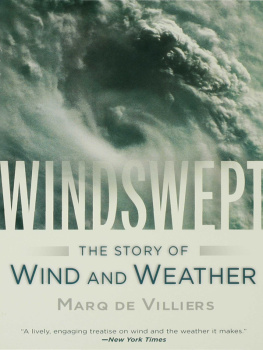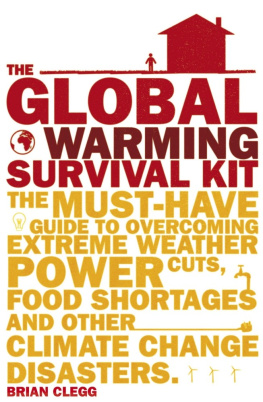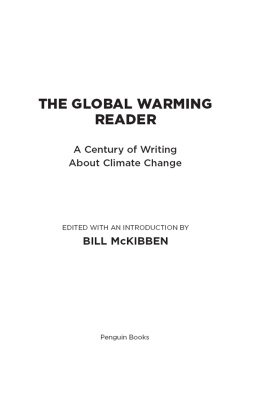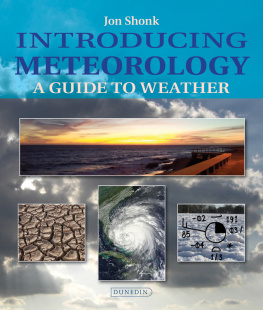Why the Wind Blow
Also by Matthys Levy:
with Mario Salvadori
Why Buildings Fall Down: How Structures Fail
Why the Earth Quakes: The Story of Earthquakes and Volcanoes
Structural Design in Architecture
Earthquake Games: Earthquakes and Volcanoes
Explained by 32 games and experiments
with Richard Panchyk
Engineering the City: How Infrastructure Works
Why the Wind Blows
A History of Weather and Global Warming
MATTHYS LEVY
Illustrations by
Sue Storey

Published by Upper Access, Inc., Book Publishers
87 Upper Access Road, Hinesburg, VT 05461
802-482-2988  www.upperaccess.com
www.upperaccess.com
Copyright 2007 by Matthys Levy
All rights reserved. Brief quotations for review or analysis are welcomed, as long as full attribution is included. For permission for longer quotations or other use, contact the publisher.
Cover design and interior layout by Kitty Werner, RSBPress LLC Illustrations by Sue Storey
Polar bear photo Martin WillFotolia.com
Storm photo Kitty Werner
Back cover glacier photo Stephan HoeroldiStockPhoto.com
Authors photo by Kitty Werner
ISBN: 978-0-942679-31-1
(ISBN 10: 0-942679-31-8)
Library of Congress Cataloging-in-Publication Data
Levy, Matthys.
Why the wind blows : a history of weather and global warming / Matthys Levy ;
illustrations by Sue Storey.
p. cm.
ISBN 978-0-942679-31-1 (alk. paper)
1. Weather. 2. Global warming. I. Title.
QC981.L499 2007
551.5--dc22
2006038756
Printed on recycled acid-free paper in the United States of America
07 1 2 3 4 5 6 7 8 9 10
Contents
APPENDICES
Acknowledgments
The critical review and valuable suggestions provided by Dr. Margaret A. LeMone of the National Center for Atmospheric Research and Dr. Alan K. Betts of Atmospheric Research helped in the development of what were scattered thoughts. The manuscript evolved over a period of years and was also read by colleagues and friends too numerous to name who gave me comments that I found invaluable in reshaping the work. I am also indebted to my publisher, Steve Carlson, who undertook this work with enthusiasm and to Kitty Werner, who led me to the publisher and prepared the manuscript for publication. Finally, I am grateful to my wife, Julie, for her support through the long process that finally led to the publication.
Introduction
All the fountains of the great abyss burst forth,
and the floodgates of the sky were opened.
Genesis 7:11
After having written, with my mentor and friend, the late Mario Salvadori, stories of why structures fail and the causes and consequences of earthquakes and volcanoes, I felt the need to continue exploring the origins and effect of natural forces. The most powerful of all is the force that gives us life, warms our planet, bathes us in light, and causes all weather related disasters: the suns radiation.
Every day, somewhere on Earth it rains, perhaps in a torrent; the wind blows, perhaps with the force of a hurricane or typhoon; and it snows; perhaps as a blizzard. As a youngster, I spent one summer camping on an island in the middle of a lake when the sky turned grey and stormy. For days, we were drenched by rain and the wind blew, raising whitecaps on the normally calm surface of the lake, preventing us from taking our canoe to reach the shore to restock our dwindling food supplies. Naively, I thought we would never escape our island prison and, more importantly, that I would starve to death. My father reassured me that neither would happen and after three days the storm abated and I was saved. Since then, I have experienced the fury of a North Pacific storm while on a troopship, blinding Northeast snowstorms, and devastating flooding, but all were mild compared to the destruction wrought by God in the biblical story of Noah.
Before unleashing forty days and nights of rain, as punishment for mans wickedness, God commanded Noah to build an ark to save selected species of animals and birds. The ark was to be 134 m (440 ft) long, 22 m (73 ft) wide and 13 m (44 ft) high, and have three decks. Noah had seven days to complete the task (quite a job for a 600-year-old man) before the floods came and covered the highest mountains, wiping out all living things except those safely ensconced on the ark. The story was apparently derived from a Mesopotamian tale of a great flood preserved in the eleventh tablet of the Gilgamesh Epic with one difference: That ark was a 54 m (176 ft) cube.
The story fails to take into account a physical reality. Of all the water on Earth, 97% is already in the oceans and 2% is in the form of ice, mainly in the polar caps. The remaining 1% is in all the lakes, rivers, underground water, and in the air as water vapor. If all of todays glaciers were to melt, the sea level would rise 70 m (230 ft). It is therefore impossible for the entire worlds water to cover the highest mountains. While the story is certainly apocryphal, it is nevertheless symbolic of the devastation that can be caused by natural forces in a particular area. The limited world of the storys writer could indeed have been destroyed by a flood, as the areas of every great river basin are, even today, periodically flooded. It is known that the Black Sea was once a fresh-water lake, about two thirds of its present size. About seventy-five hundred years ago, after melting glaciers had raised sea levels following the end of the last ice age, the Mediterranean Sea breached the Bosporus Valley. Salt water poured in from the Sea of Marmara, raising the level of the Black Sea by almost 180 m (600 ft) and extending its boundaries. As the water level rose about 150 mm (6 in) per day, the inhabitants along the shore of the Black Sea would have viewed the event as a great flood, perhaps giving rise to the biblical tale.
The story of weather is totally intertwined with the story of humankind. About forty-two hundred years ago, the cradle of civilization, in the verdant Garden of Eden in the fertile crescent between the Tigris and Euphrates rivers, was devastated by a three-hundred-year-long drought. A dry, barren landscape replaced the lush fertile valley and destroyed the thriving agricultural society that had developed there. It was all part of a long-term cooling and drying cycle that still affects us today. In ancient Mesopotamia, not only were there gods of war (Ishtar) and water (Ea) among others, but weather was recognized with its own god, Adad.
The Chinese had observed sunspots, those dark seas on the face of the sun that indicate solar magnetic storms, before the first millennium. Over time, intense sunspot activity had been found to follow an eleven-year cycle. However, suddenly during the 16451715 period, sunspot activity decreased dramatically, virtually coincident with a period of intense cold in the Northern Hemisphere that was called the Little Ice Age. This and many more examples demonstrate the influence of weather on human activity.
A little over a century ago, there began an ominous trend that continues to this day whereby human activity began to influence future climate. Man had always tried to control the consequences of weather phenomenabuilding shelters to provide a shield from rain, snow, and extremes of heat and cold; conduits to channel rainwater; and breakwaters to calm ocean waves and create a safe port. There have also been attempts at active manipulation of weather, such as by cloud seeding to create rain. Passive changes took place starting in the late nineteenth century, fueled by rapid industrialization, an expanding use of carbon-based fuels, and a booming population. Climate change is now in the throes of global warming that can no longer be attributed to natural long-term trends. Although changes that can be ascribed to global warming arrived gradually at first, that may no longer be true in the twenty-first century, as significant and possibly abrupt changes in climate may be expected on our planet.
Next page








 www.upperaccess.com
www.upperaccess.com